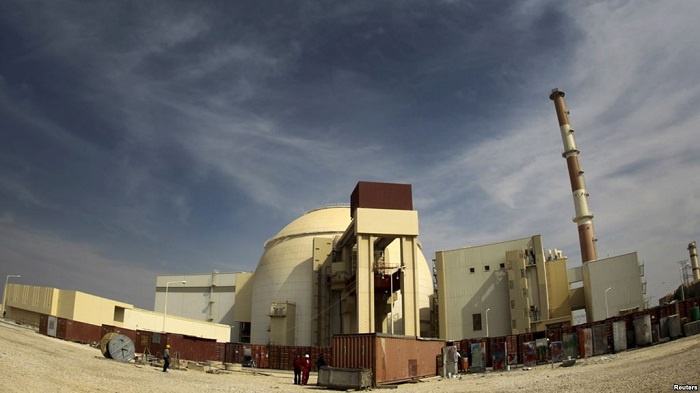Iran’s Decision to Expand Nuclear Capacity, First Step to Withdraw from the Nuclear Deal, or a Bargaining Chip?

In his traditional speech on the anniversary of Ayatollah Khomeini’s death, Iran’s Supreme Leader Ayatollah Khamenei instructed the government to lay the foundations for 190K SWU uranium enrichment capacity. “The West's dream regarding the JCPOA will not come true, and the Iranian nation and government will not tolerate being under sanctions, while limited in the nuclear field” he said. “The Atomic Energy Organization of Iran must make the necessary arrangements to reach 190,000 SWU in the framework provided by the JCPOA, and it must begin some other preparations that Mr. President has ordered effective tomorrow”. President Hassan Rouhani has ordered Iran’s Atomic Energy Organization to begin the “manufacturing of UF6, a factory for UF4, and the construction of new center for manufacturing centrifuges” head of the organization Ali-Akbar Salehi said on Tuesday. Iranian Diplomacy has interviewed Ali Khorram, Iran’s former ambassador to China and Iran envoy to UN Geneva office on how we should interpret Iranian leaders’ recent decisions, and likely scenarios awaiting the nuclear deal, the so-called Joint Comprehensive Plan of Action (JCPOA):
IRD: Analysts have interpreted Supreme Leader Ayatollah Khamenei’s order to the government to prepare the groundwork for creating 190K SWU enrichment capacity as a call to return to the pre-JCPOA era, and as Iran’s withdrawal from the nuclear deal. How do you interpret Ayatollah Khamenei’s order?
AK: There are several points we should attend carefully. What Ayatollah Khamenei ordered in his Monday speech was preparation to reach the 190K SWU capacity. We have not taken any action to this end so far. Creating this capacity is a lengthy process, and cannot be accomplished within a week, a month, a year, or so. So even if we kick off the 190K SWU project right at this moment, it will take a long time before we reach the goal.
The second point is that the Supreme Leader ordered this ‘within the boundaries of the nuclear deal’, the JCPOA. That means Iran’s efforts to reach the 190K SWU capacity will not violate terms and conditions of the nuclear deal. No action will be carried out until nuclear diplomacy is fully exhausted and we become certain about the fate of the JCPOA. So this order is not tantamount to Tehran’s withdrawal from the nuclear deal.
IRD: Will Europeans, and other signatories to the JCPOA, look at the order from a similar viewpoint?
AK: Definitely not. They will have their own interpretation from this speech and act according to that interpretation. Iran’s new path in its nuclear program will be taken into account by other parties to the nuclear deal, and they will announce their new approach towards the nuclear saga soon. Thus, the order may lead to misinterpretations among other parties.
IRD: How will Washington react to the order by Iran’s Supreme Leader? Could the order bring the US and other powers closer and shape a global consensus over Iran’s diplomatic, defense and nuclear programs?
AK: The situation is not ripe yet for such a consensus to take shape. But if nuclear negotiations eventually lead to Iran’s withdrawal from the JCPOA, we could expect a global consensus against Iran’s defense and nuclear programs, plus its regional policies. Iran’s exit from the JCPOA means the end of the nuclear deal. In that case, neither the Europeans nor the Russians and Chinese are obliged to cooperate with Tehran.
IRD: Is President Rouhani’s order to Iran’s Atomic Energy Organization to start production of UF4, UF6, and assembly centers for new machines another step by the government to leave the nuclear deal?
AK: We cannot be sure about that. I believe President Rouhani is buying time from both domestic and international actors with this order. Domestically, his order aims to bring him some time to become certain about the fate of the JCPOA. Internationally, it helps Iran to resume peaceful nuclear activities if negotiations with other parties failed to bring result. But this order can have adverse impact on trade relations between Iran and international banks or companies.
IRD: How do you see the future of the nuclear deal?
AK: Both sides are eyeballing each other. As I said, Ayatollah Khamenei’s order is not equal to Iran’s decision to withdraw from the nuclear deal. Rouhani’s order is also aimed to buy more time. So there is still chance to save the JCPOA. But we should also be realistic. If negotiations fail to lead to Tehran’s favorite outcome and if an atmosphere of mistrust and misinterpretation prevails, then the order to prepare for the 190K SWU nuclear power is the first step to return to the pre-2013 years and cancellation of the nuclear deal.
IRD: Is there a possibility that Iran also leaves the NPT and the Additional Protocol?
AK: Orders like preparation for the 190K SWU nuclear power are not released without their consequences being calculated beforehand. Leaving the Non-Proliferation Treaty and the Additional Protocol are worst case scenarios. Voices inside Iran who call for withdrawal from these agreements should have their consequences in mind. What we need at this moment is diplomatic tact and intelligence.
* This piece was initially published in Iranian Diplomacy Persian on Wednesday, June 6, 2018.

